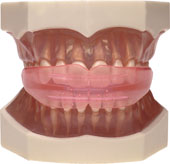 |
 |
 |
 |
|
Contents Introduction Indications
for the Contra-Indications
for the |
Treatment for children from 6 to 10 years with a developing malocclusion
Incorporating
Tooth Guidance
Myofunctional Training and
Jaw Positioning
Introduction
There are 3 components
to a malocclusion:
TOOTH,
MYOFUNCTIONAL (as described by Angle) and
JAW POSITION
Most orthodontic techniques treat only the dental component. Some treat Tooth and Jaw. The Myofunctional component is most often ignored. This can slow treatment and be the cause of relapse. The Pre-Orthodontic TRAINER¨ allows treatment of the 3 components of a malocclusion.
The pre-Orthodontic TRAINER¨ is a Combined Functional and Tooth Guidance Appliance developed from the need for a more comprehensive early treatment.
In many Orthodontic cases, tongue position and incorrect swallow is a major cause. The Trainer has a tongue tag for proprioceptive location of the tongue tip into its correct resting position. The child learns where this position is with the Trainer in place and this acts as a "reminder" where this "spot" is.
The Tongue guard prevents a tongue thrust swallow when in place, which is a position "training" process for the tongue.
Lip bumpers or Mentalis stretchers are incorporated to stretch and deactivate overactive mentalis contraction, associated with a tongue thrust swallow. 6 Lip bumpers have been shown to gain arch length in mild to moderately crowded cases. 3
Assistance to the Orthodontist can be given for future orthodontic treatment with pre-treatment using the Trainer, in closing open bites and opening deep bites, simply by removing the detrimental effect of the tongue and the peri-oral musculature on the anterior dentition, prior to regular orthodontic treatment.
In Europe, the concept of early treatment of orthodontic problems in the growing child has persisted for the majority of the century. The functional appliance is used for redirection of growth and, combined with arch expansion, has been a popular choice for many common malocclusions. More widespread adoption of these techniques, particularly in North America has been limited by the inherent disadvantages and criticism of so called functional appliances.
The advantages of functional appliances are early treatment of malocclusion, orthopaedic effects on the bone allowing for the correction of skeletal malocclusions not possible with dentally fixed appliances.
General disadvantages are lack of ability to align the teeth, plus complex and expensive construction. The more the appliances are developed to improve their performance, the more prone they are to breakage and poor compliance. Furthermore, despite their name, few functional appliances do not have significant effects on the soft tissue. ie; correction of tongue thrusting, reverse swallowing, oral habits and mouth breathing, all of which have been shown to greatly influence growth and dental alignment.1, 3, 7, 9 Furthermore, many functional appliances discourage correct tongue position and function tending to produce the effects demonstrated by the Harvold experiments of the 1960's on primates.
More recently there has been a trend to combine a two phase system to obtain the best of functional and fixed appliance treatments, recognising the shortcomings of both systems used separately.
From this need the pre-Orthodontic TRAINER¨ was developed as a definitive early treatment for the child 6-11 years - the ages when traditionally functional appliances work best. The intention was to produce an easy to use prefabricated device with the orthopaedic effects of a functional appliance, combined with a tooth guidance system, plus an unique myofunctional training feature. The product does not require manufacture in the laboratory and is made in a universal size for all children 6-11 years (mixed dentition stage), allowing orthodontic treatment to be implemented earlier and at lower cost. The application of a tooth guidance into a functional appliance overcomes one of the major disadvantages of other functional appliances.
| Home
|
| The Pre-Orthodontic Trainer | The
Trainer for Braces |
| The TMJ Appliance | New Products
|
Patent No. 5 259 762

